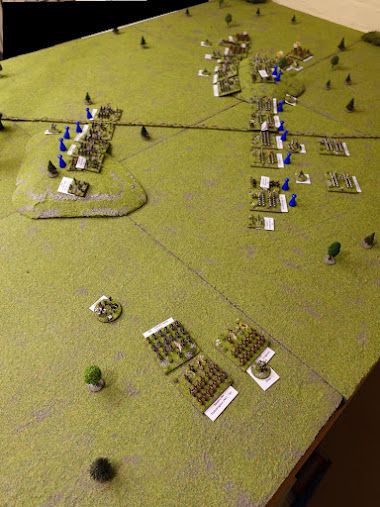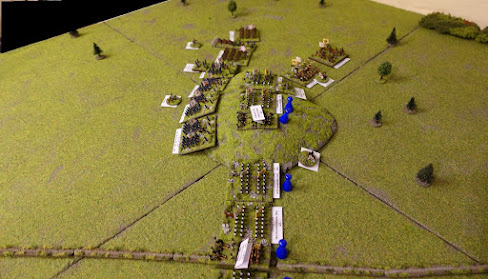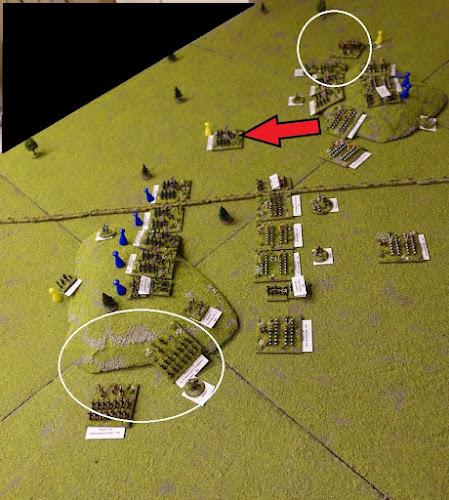A number of the Rejects gathered online to continue their Volley and Bayonet education by playing this fictional scenario.
What was also being tested was a return to using full movement in conjunction with a revised pre-game move/deployment.
Background
and Campaign Context
The French
Revolutionary army has pushed the Austrian army back beyond its fortress city
of Mantua, and now besieges it. A relief army led by Wurmser seeks to break the siege and push the French back
along the Po valley. Whilst, the main armies manoeuvre around Lake Garda,
forces have been deployed to protect the eastern flanks. Massena, leading the French troops, seeks to
push Wurmser away and reduce the threat to the siege. Meanwhile, Wurmser is hoping to force Massena
back towards Mantua and threaten both the siege and possibly the rear of
Napoleon’s army at Rivoli. Defeat for
either need not be catastrophic so long as the army is not utterly exhausted.
The
engagement is all about forcing the enemy to retreat, by either breaking the
army or threatening their line of communication (LOC).
The
encounter is caused by the two armies marching towards each other, the French
from the southwest and the Austrians from the northeast. It starts at 2pm. The sunsets at 8pm, with it becoming dark by
9pm.
Both sides may move their forces on from their designated LOC – the Mantua-Verona Road, and 3 inches either side. The assumption for this game is that all units have already shaken out of march column, unless specifically instructed to move in march column.
Both sides had to submit their orders to me. The units were then moved simultaneously on the table.
· Units could not move closer than 24 inches and line of sight, whichever occurred first.
Start of
Game: Each side has the option to retire any units
the minimum required to be outside of charge range. This will be directly away from the nearest
enemy formed unit. Both sides will
secretly declare their intentions to the umpire via the Zoom chat facility.
Game
length: 8 turns including deployment orders. Seven turns on the table. After which night falls.
The Armies
Victory
conditions: The side that holds the opposing LOC at the end of the 9pm turn wins. In the event of neither or both achieving
this then the winner will be the side that has fewer divisions exhausted. Alternatively, when one side decides to
withdraw to maintain the integrity of its wider mission and still has at least
33% of its division in good order to effect an orderly withdrawal.
In the
event of a draw, a second day of battle may occur. In a campaign this may see the arrival of
reinforcements during the course of the day.
Campaign
Light Cavalry Points:
For this game only, each side will roll a 1d3 at the beginning of the
game. This can affect any post-battle
pursuit and casualties, and who may be player one once battle is joined at the
table. This is to try and reflect what
may be a mechanic in a campaign.
Terrain:
The hills block line of sight, but do not impede movement.
Mantua-Verona
Road: Units in march column on a road
may move at three times their normal speed.
The sides submitted their first turn moves via email. The resulting dispositions being as follows with neither side in charge range.
 |
| Austrian cavalry turning the northern flank... a bit blurred! |
 |
| Austrian cavalry turning the southern flank. |
Massena having previously expressed a willingness to withdraw, now declared a French retreat. The Austrians had gained the field. With cavalry advantage, the Austrians roll for post-battle pursuit and eliminate two extra strength points from the French army.


















Excellent battle recap! I am quite surprised at the result. I figured the French would have an easier time of this than they actually did. That is why we play the game!
ReplyDeleteThank you Jonathan. I was a little surprised too. I'm not sure that the French were very coordinated, nor used their better units effectively. It is still a learning curve.
DeleteI am enjoying reading your posts as you delve into some volley and bayonet games.
ReplyDeleteThank you Peter. I am enjoying putting them on and reporting them. It's satisfying to see how the players develop their understanding and turn to concentrating on tactics.
DeleteAnother great looking and reading game, Richard, and an excellent advertisement for the smaller scale figures too!
ReplyDeleteThank you for your very kind comment Keith.
DeleteThis comment has been removed by the author.
ReplyDeleteJeez....that's the second time this has happened in twelve hours! I press Publish, a message comes up saying an error occurred, I press Publish again.....then the comment appears twice! Don't know if it's Blogger or my ancient iPad causing it!
DeleteI had that same problem earlier... must be Blogger!
DeleteAnother fine scenario there Richard and good to see everyone getting to grips with the rules now and the nuances contained therein. The Commission Figurine figures look superb as always. I like the campaign light cavalry roll at the end, which is a nice touch and a good idea.
ReplyDeleteThanks Steve. Everyone is moving onto worrying about tactics and less about the rules.
DeleteGlad you approve of the campaign touch.
Great report Richard. What I like about the rules is they make you play more to the period. Its key to have a reserve. The French didn't have one and that helped them to lose the game. Great game and a great set of rules. Looking forward to playing and learning more!
ReplyDeleteCheers Ray. If the rules reward historical tactics then they have done something right.
DeleteAn interesting AAR, and a little unusual with the diagonal aspect of the encounter. The full movement rate seemed to fit nicely in this battle. Perhaps it was just a matter of becoming more familiar with the rules?
ReplyDeleteThanks Lawrence. Agreed, familiarity is making for wiser decisions... most of the time!
DeleteVery impressive gaming, Richard. Great scenario, and all the more amazing being played remotely.
ReplyDeleteKind of you to say so Dean.
Delete